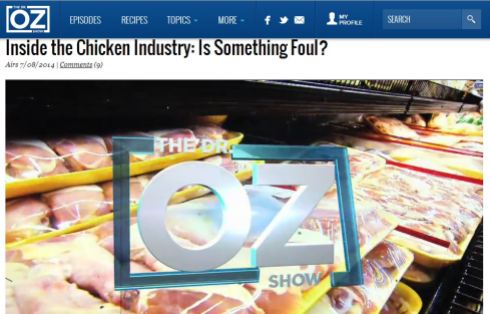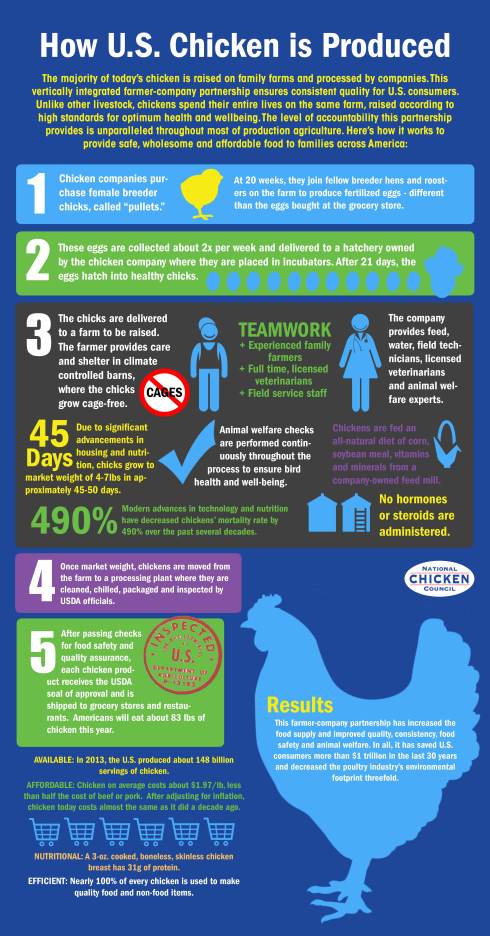Cue the scary video images and dramatic voiceover. Dr. Oz is at it again.
In an episode on his TV show today, he apparently “exposes the horrors” of conventional chicken production.
The full episode isn’t available on his website as of yet so, unfortunately, I haven’t been able to watch it all, but judging from the trailer, it looks like classic Dr. Oz.
- 95% of us eat chicken every day … but is it safe?
- Chickens go through multiple chemical baths in the slaughterhouse!
- Gut-busting bacteria in chickens may be contaminating your food!
All the “good” stuff.
Only it’s not the accurate story. It’s more fear mongering than anything.
And if you’ve read some of my blog posts, you know I can’t stand that sort of fear marketing of our food system – the safest food system in the world, I might add.
Dr. Oz, by the way, just got called out a few weeks ago by Congress for, in fact, touting weight loss miracles that are anything but proven weight loss miracles. (You can read more here.) I’m hoping more and more people will come to see his true colors.
But I digress. Let’s go back to conventional chicken farming. While I regret that the full Dr. Oz episode hasn’t been posted for viewing yet, based on the trailer, I think I can cover a few general areas of information that are useful.
First, let’s start with the safety of the chicken you and I eat.
- Americans eat 160 million servings of chicken every day (EVERY DAY!) and virtually all of them are eaten safely.
- Raw poultry products certainly may contain naturally-occurring Salmonella. (So do fruits, vegetables, fish, etc., for that matter.) Chicken, however, is safe to eat 100% of the time when properly handled & cooked to 165 F.
- The chicken industry has reduced Salmonella to all-time low levels. I work in the poultry industry every day and I can tell you straight out that farmers and food companies alike are doing everything they can to minimize salmonella in poultry as much as possible. They research and study and work together to figure out the best ways to raise and process these birds. Salmonella is taken very seriously – after all, we all want safe, healthy chicken on our tables.
For more information on Salmonella and food safety in chicken, click here.
So what about those chemicals used in chicken processing plants?
There are food-grade antimicrobials approved for use by the U.S. Department of Agriculture and the Food and Drug Administration as a safe and effective way to kill potential bacteria, like Salmonella.
“Antimicrobials” are things like paracetic acid (PAA), chlorinated water and cetylpyridinium chloride (CPC). These sound scary but aren’t nearly so terrible when you know what they are.
Peracetic acid, for example, is an organic compound of, basically, vinegar and hydrogen peroxide. It is permitted for use in both conventional poultry products and those labeled as “organic,” as well. Here’s a great (short) video from a veterinarian I know personally who talks about the safety of paracetic acid:
[youtube https://www.youtube.com/watch?v=MCxxdgXom4w%5D
And CPC is an antiseptic that kills bacteria and other microorganisms and is commonly found in toothpaste, mouthwash and nasal sprays.
For more thorough information, head to this link for a Q & A on what chemicals are approved for use in chicken processing.
Of course, the other component of the conventional chicken story is what’s called “vertical integration” – in other words, companies that handle all aspects of chicken production, from hatching and raising to processing and packaging.
Dr. Oz implies this is inherently bad – probably because it doesn’t sound very “Farmer in the Dell” or “Old McDonald-like”.
Well, the truth is chicken farming has evolved over the past several decades, just like everything else in our lives. Americans eat a lot of chicken (over 83 pounds per person per year!), and we need all kinds of chicken production to make this happen. We need large chicken companies and the 29,500 family farmers ( like Minnesota chicken farmer, Bill, pictured above) who work with them to raise the quantity of chickens purchased in grocery stores, restaurants and other foodservice establishments. (And I haven’t even mentioned the chicken that’s exported to other countries.) These companies and farmers provide consistently high quality and safe chicken and yield a variety of innovative chicken products for millions of people.
We also need other types of chicken production, including organic and smaller flocks for niche markets and other sources. Truth is, none of these production methods are inherently good or bad – it’s not that black and white; farming never is – so let’s please stop the chicken bashing.
That goes for you, too, Dr. Oz.
You can find more information about chicken farming at http://www.chickenroost.com and at http://www.mnchicken.org.
And please feel free to share any comments or questions you have about chicken. I am happy to track down answers for you from actual chicken farmers and chicken companies. (Infographic below courtesy of the National Chicken Council.)



Great post!
Many folks figure that “backyard/pastured” poultry MUST be better than “the industry” because it is more NATURAL. While I think that choices are great…and I raise pastured poultry…the industry does much to protect the environment and the consumer at every step of the process and it is good to get that knowledge out there.
I was unaware of this fact until I spoke with a former inspector about her time on the poultry processing lines. Her experiences were eye-opening.
Thank you for explaining the chemicals used in processing. I have a customer who is terrified of what she refers to as “the solution” that she says she has heard drenches every bit of meat that is available at the store. (yes, she does watch Dr. Oz)
Shame on Dr. Oz! Apparently, he took nothing away from his little reprimand on Capitol Hill.
You are absolutely right that ” We also need other types of chicken production, including organic and smaller flocks for niche markets and other sources. Truth is, none of these production methods are inherently good or bad – it’s not that black and white; farming never is – so let’s please stop the chicken bashing.”
…and Dr. Oz needs to remember not to talk with food in his mouth!
Thank you! I read your blog and I think you do a great job of explaining how you raise poultry. I firmly believe we need all types of production and I hate to see consumers (any of us!) bash one type of production over another. I think most farmers are doing the best they can, regardless of what type of farm they have. And I’m so tired of the old “corporate” or “factory farm” labels … they just don’t sit well with me and that’s not what I see on a day to day to basis. Couldn’t agree with you more – thanks for your comments!
Thanks for helping to set the record straight! That man is a total quack that’s made way too much money scaring people with his thinking.
I couldn’t agree more, NMyla! Thanks for reading and sharing your thoughts.
Thanks for writing such fantastic posts! I work in the specialty egg industry in Iowa (and attend the MWPC in St. Paul every Spring!) and I’m constantly fielding customer concerns because of sensationalist media like this. It’s also great to see your support of the poultry industry beyond the Midwest. Dr. Hargis was one of my favorite professors at the University of Arkansas, and I think he does great work for the industry.
Thank you so much, Laura! I appreciate your comments and will continue to do what I can to make sure correct information is available. I was so glad that Dr. Hargis had a video like this that I could share – it’s such great information and I agree – he does an outstanding job.
Great post Laura. I feel like people are starting to question Dr. Oz more and more and by sharing accurate information, like you have in this post, will help everyone that is looking for the truth. Keep up the great work and thanks for sharing!
Thanks, Val! I hope so, and I’m definitely hearing more and more of my friends/family/followers say the same thing … 🙂 Thanks for reading and commenting!
Thanks for such a great, thorough post and for your agvocacy!
Thanks, Sarah – It’s been fun to get to know you through our Facebook group and I enjoy your blog very much! Thanks for sharing this post, as well. 🙂
I find it interesting that consumers buy all sorts of products (cars, lumber, toothpaste, computers diapers,etc.) made in large factories that take advantage of economies of scale. Why can’t agriculture do the same and pass those savings on to us? Old MacDonald can’t feed them all. And, family farms are doing the lion share of the work. Don’t run down a farmer with your mouth full !!
I agree wholeheartedly – and love your statement, “Don’t run down a farmer with your mouth full!” Thanks for commenting!
Well said!
Thanks for a well written article on chicken production. I work for a company that makes and sells food safety interventions, like PAA, lactic acid, and Chixide. These products help ensure safe food. I don’t think that some of these consumers realize what they’ll be left with if they get rid of all food technology. No one wants an artisan iPhone, why do they insist on innovation free food?!
Thanks!
Thanks, Kellie – I appreciate your comments and agree 100%. Most people seem to hear something like “Chixide” and automatically assume it’s bad without any research or information. (Welcome to the Internet, I suppose.) Glad I could shed some light!